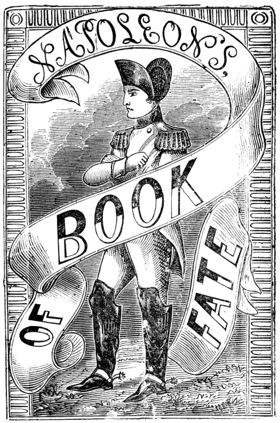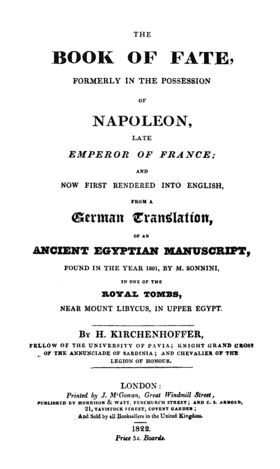Napoleon's Book of Fate
From Kook Science
Napoleon's Book of Fate (or the Emperor Napoleon's Book of Fate, Oraculum, etc.) is an English translation of a divinatory guide that has been described as being a secondary translation from German of an ancient Egyptian manuscript said to have been discovered by one M. Sonnini (Sonini) in 1801 at "one of the Royal Tombs" near "Mount Libycus, in Upper Egypt," and credited as being based on the edition formerly in the possession of Napoléon Bonaparte, who, it was claimed by the vendors of the book, used the system to some success.
Provenance
Per the W. R. Walker edition:
- The Book, of which the following is a translation, was obtained from Buonaparte's Cabinet of Curiosities, at Leipsic [Leipzig], during the confusion which reigned there after the defeat of the French army. It was held by him as a sacred treasure; and it is said to have been a stimulus to many of his speculations, he being used to consult it on many occasions. It is supposed to be the only copy in the world, being written in the German language, nearly five hundred years ago.
Per the James Cornish edition:
- It is well known that in Napoleon's military expedition to the east in 1801 he took with him some of the most learned men of France for the purpose of exploring the Arts and Antiquities of Egypt. Among these was the celebrated M. Sonini, who having with much labour perforated a passage into one of the royal tombs near Mount Libycus, found therein an ancient roll of papyrus, richly ornamented and covered with hieroglyphics: this was conveyed by M. Sonini to the first consul; a learned Copt was sent for to interpret it, who, with the assistance of an eminent German scholar, soon found out a key to decipher and translate it into the German language. The original as well as the translation were locked up by Napoleon in his secret cabinet, consulted on every occasion, and was the means of determining many of his boldest and most successful enterprises. After the defeat and confusion of the French army at Leipsic [Leipzig], this translation, emblazoned with Napoleon's arms, fell into the hands of a Prussian officer, by whose permission the present translation was made.
Friedrich Max Kircheisen in Bibliographie du Temps de Napoléon: Comprenant l'Histoire des États-Unis (1908), p. 94-95, gives "M. Sonini" the full name of Charles Nicolas Sigisbert Sonnini de Manoncourt, the translator as Herman Kirchenhoffer, fellow of the University of Pavia, and describes the English edition as having first been published in 1822. Additionally, Kircheisen notes the existence of a Spanish edition, Oráculos de Napoleón ó sea la Rueda de la Fortuna para Adivinar la Suerte Presente y la Futura de las Personas (Sevilla, c. 1880), and a Welsh edition, Oraculum Bonaparte: Trwy yr hwn y gellir cael allan wybodaeth o ddygwyddiadau dyfodol; ysgrifenedig yn iaith Germany (Llanidlos & Rhayader, c. 1854), and his own translation of the English edition into German as Das Orakel, oder Napoleon's Schicksalsbuch in Hat Napoleon gelebt? (Stuttgart, 1910).
Editions
- Kirchenhoffer, H. (1822), The Book of Fate, Formerly in the Possession of Napoleon, Late Emperor of France; and Now First Rendered into English from a German Translation of an Ancient Egyptian Manuscript, Found in the Year 1801, by M. Sonnini, in One of the Royal Tombs, Near Mount Libycus, in Upper Egypt, London: Printed by J. McGowan, Great Windmill Street, Published by Morrison & Watt, Fenchurch Street; and C. S. Arnold, 21, Tavistock Street, Covenant Garden; And Sold by all Booksellers in the United Kingdom
- Napoleon's Book of Fate, Royal Arcade, Newcastle-Upon-Tyne: W. R. Walker, https://archive.org/details/fisherchapbook480
- Napoleon's Book of Fate, or Philosopher's Inquirer into Future Events, S. a. et l., circa 1820 — described as "An American chap-book"
- Kirchenhoffer, Hermann (1835), The Oracle or Book of Fate: Formerly in the Possession of the Emperor Napoleon, and Now First Rendered English, from a German Translation, of an Ancient Egyptian Manuscript, Found in the Year 1801, by M. Sonnini, in One of the Royal Tombs, near Mount Libycus, in Upper Egypt (22d ed.), London: M. Arnold, https://catalog.hathitrust.org/Record/000583389
- Napoleon's Book of Fate: Being a Translation of an ancient Egyptian M.S. found in the year 1801, by M. Sonini, in one of the Royal Tombs near Mount Libycus, in Upper Egypt, Translated from Napoleon's German Copy, London, 297, High Holborn: James Cornish, 1852, https://books.google.com/books?id=2uZhAAAAcAAJ&pg=PT12
- Napoleon's Book of Fate, London, "The West-End News" office, 475, Oxford-street: Elliot's Sixpenny Books, circa 1860
- Napoleon's Oraculum and Dream Book, Containing the Great Oracle of Human Destiny, Also the True Meaning of Almost Any Kind of Dreams, Together with Charms, Ceremies, and Curious Games of Cards, New York: Frank Tousey, Publisher, 34 and 36 North Moore Street, 1884, http://iapsop.com/ssoc/1884__anonymous___napoleons_oraculum.pdf
- Napoleon's Oraculum; or, Book of Fate: Only Complete America, from the Fiftieth London Edition, Philadelphia: Fisher & Brother, c. 1899, https://catalog.hathitrust.org/Record/008916197
- Kirchenhoffer, H. (circa 1900), The Book of Fate: Formerly in the Possession of Napoleon, Late Emperor of France, and Now First Rendered into English from a German Translation of an Ancient Egyptian Manuscript Found in the Year 1801 by M. Sonini in One of the Royal Tombs Near Mount Libycus in Upper Egypt, London: Anglo-American Author's Association
- Kirchenhoffer, H. (1923), The Book of Fate: Formerly in the Possession of and Used by Napoleon, New York: H.S. Nichols, https://catalog.hathitrust.org/Record/011202637
- Napoleon's Lucky Dream Book, Oraculum & Book of Fate

